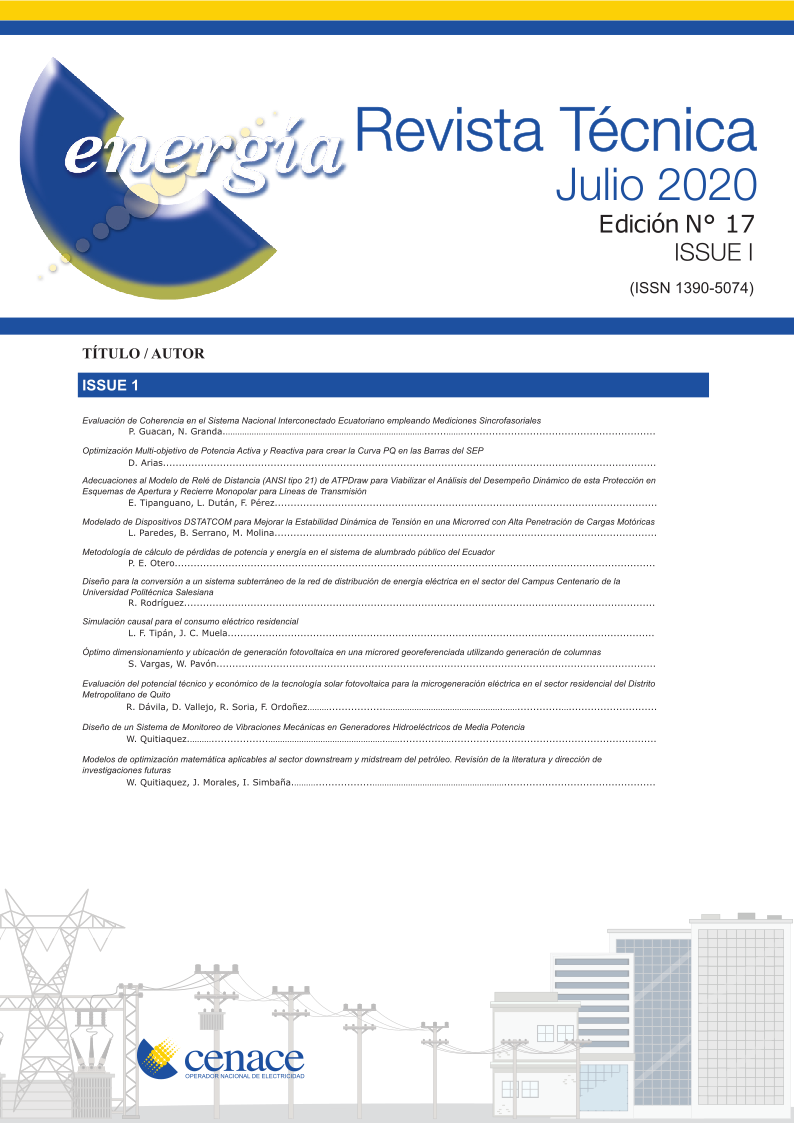Multi-objective Optimization of the Active and Reactive Power to PQ curve of the Power System Bus
Main Article Content
Abstract
In this work, a problem of multiobjective optimization of active and reactive power in the bars of the system is proposed, which considers the operating limits, the generation capacity, the reactive power reserves, the active power capacity, the transmission restrictions, and the voltage limits of the electric power system (SEP).
The proposed multi-objective optimization problem is based on a combination of the objective function1: reactive power margin and the objective function 2: active power, in the bar subject to analysis of the SEP margin. From the multiobjective problem the Pareto Border is obtained, which represents the PQ curve (projection of the PV and QV curve on the plane) of the bar under analysis. The optimization problem model is applied to a test system for its validation and analysis of results. In this way, a reliable measure is provided to evaluate the voltage stability and the security of the system in electrical networks considering the maximum operating limits of the SEP.
Downloads
Article Details
Aviso de Derechos de Autor
La Revista Técnica "energía" está bajo licencia internacional Creative Commons Reconocimiento-NoComercial 4.0.
References
[2] V. Ajjarapu, P. L. Lau, and S. Battula, “An Optimal Reactive Power Planning Strategy Against Voltage Collapse,” IEEE Trans. Power Syst., vol. 9, no. 2, pp. 906–917, 1994.
[3] H. Barot and K. Bhattacharya, “Optimal Reactive Power Planning and Compensation Effects on Transmission Loss Components,” in Power Engineering Society General Meeting. IEEE, 2007, pp. 1–7.
[4] T. Van Cutsem, “A Method to compute Reactive Power Margins with respect to Voltage Collapse,” IEEE Trans. Power Syst., vol. 6, no. 1, pp. 145–156, 1991.
[5] Q. Liu, J. Liu, J. Shi, and Y. Huang, “A New Method to Compute Reactive Power Margin,” in IEEE International Conference on Industrial Technology. ICIT 2008., 2008, pp. 0–5.
[6] X. He, X. Pang, D. R. Zhu, and C. X. Liu, “Multi-objective reactive power optimization based on chaos particle swarm optimization algorithm,” in Proceedings - 2013 2nd International Symposium on Instrumentation and Measurement, Sensor Network and Automation, IMSNA 2013, 2013, no. 1, pp. 1014–1017.
[7] Z. Li, M. M. Begovic, and X. Duan, “Reactive power planning using a two-level optimizer based on multi-objective algorithms,” in 2009 15th International Conference on Intelligent System Applications to Power Systems, ISAP ’09, 2009, pp. 1–6.
[8] J. Vallejos, U. Fernández, and R. Ramos, “Multiobjective reactive power compensation applied to the Paraguayan power system,” in 2006 IEEE PES Transmission and Distribution Conference and Exposition: Latin America, TDC’06, 2006, vol. 00, pp. 1–6.
[9] N. Krami, M. A. El-Sharkawi, and M. Akherraz, “Pareto multiobjective optimization technique for reactive power planning,” in IEEE Power and Energy Society 2008 General Meeting: Conversion and Delivery of Electrical Energy in the 21st Century, PES, 2008, pp. 1–6.
[10] H. Singh and L. Srivastava, “Recurrent multi-objective differential evolution approach for reactive power management,” IET Gener. Transm. Distrib., vol. 10, no. 1, pp. 192–204, 2016.
[11] P. Dong, L. Xu, Y. Lin, and M. Liu, “Multi-Objective Coordinated Control of Reactive Compensation Devices Among Multiple Substations,” IEEE Trans. Power Syst., vol. 33, no. 3, pp. 2395–2403, 2018.
[12] M. Mohsen and H. Siahkali, “Multi-objective optimization of reactive power dispatch in power systems via SPMGSO algorithm,” in IEEE Proceedings 2017 Smart Grid Conference, SGC 2017, 2018, vol. 2018-Janua, pp. 1–9.
[13] J. Wu, N. Li, L. He, B. Yin, J. Guo, and Y. Liu, “Research on multi-objective reactive power optimization based on modified particle swarm optimization algorithm,” in 2010 Chinese Control and Decision Conference, CCDC 2010, 2010, pp. 477–480.
[14] W. Zheng et al., “Multi-objective reactive power and voltage optimization for distribution network,” in 2018 International Conference on Power System Technology, POWERCON 2018 - Proceedings, 2019, no. 201806150000008, pp. 2216–2221.
[15] B. Song, Y. Cao, X. Zhang, Y. Wang, and N. Li, “Multi-objective reactive power optimization in power system based on improved PSO-OSA algorithm,” in 2019 14th IEEE Conference on Industrial Electronics and Applications (ICIEA), 2019, vol. 3, pp. 1514–1519.
[16] M. Zhang and Y. Li, “Multi-Objective Optimal Reactive Power Dispatch of Power Systems by Combining Classification-Based Multi-Objective Evolutionary Algorithm and Integrated Decision Making,” IEEE Access, vol. 8, pp. 38198–38209, 2020.
[17] M. Belazzoug and M. Boudour, “FACTS placement multiobjective optimization for reactive power system compensation,” in 2010 7th International Multi-Conference on Systems, Signals and Devices, SSD-10, 2010, pp. 1–6.
[18] C. Levis, C. T. Phan-Tan, and M. Hill, “Multi-Objective Optimal Active and Reactive Power Dispatch for Centrally Controlled Distributed PV Systems,” in Proceedings - 2018 53rd International Universities Power Engineering Conference, UPEC 2018, 2018, pp. 1–6.
[19] D. Arias, L. Vargas, and C. Rahmann, “WAMS-Based Voltage Stability Indicator Considering Real Time Operation,” IEEE Lat. Am. Trans., vol. 13, no. 5, pp. 1421–1428, 2015.
[20] D. Chávez, S. Espinosa, and D. Arias, “Reactive Power Optimization of the Electric System based on Minimization of Losses,” IEEE Lat. Am. Trans., vol. 14, no. 11, pp. 4540–4546, 2016.
[21] C. Cutsem, Thierry Van; Vournas, Voltage Stability of Electric Power Systems, Publishers. 1998.
[22] T. Van Cutsem, “A method to compute reactive power margins with respect to voltage collapse,” IEEE Trans. Power Syst., vol. 6, no. 1, pp. 145–156, 1991.




